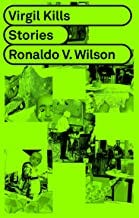Ronaldo V. Wilson’s Virgil Kills forms

The shape of a dream is always slippery. As the soul rouses from its slumber, it can be hazy, messy, putting the pieces back together. And Virgil Kills continues on this journey of glorious queering throughout its pages, a simple book of stories, prose, thinking, characters and dreams. Moving from slumber to play to performance to life, Ronaldo V. Wilson blurs the realities that face this Black Filipino gay man, using them to establish a mirror. Mirrored in Virgil’s life are the experiences known all too well to those artists and dreamers who are queer and Black.
Dreams are a place of reckoning. Dreams and nightmares haunt with their contortions of fact, the naked ways they describe our desires. When morning comes, everybody rises and puts on the necessary trappings of the day, shedding the courage and the shame of whoever they were as they slept. It is a noteworthy fact that events of a dream can bring us to tears even after the fact, that we can regret actions we made during these nightmares, though they genuinely had nothing to do with us. We can even ask ourselves if they did have something to do with us.
In these phases, when we can finally introspect about them, these uncanny valley moments of subconscious expressions are a space where we learn more about ourselves. Sitting honestly with the self revealed in the dream is an exercise for the brave heart. In this book, Wilson sits with himself, his experiences as an artist, and honesty does not even begin to describe the presence that this book carries.
An artistic powerhouse, Ronaldo V. Wilson is a celebrated poet who engages in a multitude of interdisciplinary forms of expression. Like Ronaldo, the book refuses to be changed down to one form, one story, or even one line of thinking. It morphs when it must, seeking out the relief of wit and the realization of a self. Many readers, upon falling into the work of a great artist, may fall into the trap of wishing there to be a connecting strain through all of the artist’s work. But in Virgil Kills, this self is not limited to a body, to actions in reality, or even to the ideas of others; Wilson has determined that, even as a writer, his work will continue in its boundless, rule-breaking, rule-ignoring beauty and strength.
Dreaming may be a creative act of the subconscious mind, but it is an experience similar to that of writing or a similar kind of creative expression. As we write, when we write openly and honestly, we are brought face to face with even those truths we would rather ignore. Writing openly and honestly is an undertaking unlike any other. Ronaldo Wilson compares it to a freestyle when Virgil thinks of this conclusion: “If the music in the freestyle is the language, then too, the keyboard is the instrument, a sonic place, typing, where the body is fixed against the current of sorrow.” Virgil sees his dreams as one existence where he can be sure of his presence. Fixing himself against the current of sorrows in his life, he endeavors to be who he really is. These dreams and imaginations are an escape from the forms Virgil has been coerced into, the forms he takes on for his own safety, and the forms which he has been allowed only to access in short episodes.
The sorrows and concerns of Virgil’s life are illustrated in his dreams. Fears of surveillance and betrayal color many scenes. Moments of violence, both those external to him and those that paint Virgil’s palms in a crimson shade that cannot be erased from his mind, bring into stark focus the realities which exist. From the harsh air of living within a family context where he is unaccepted or whiteness that so permeates Virgil’s world that it seems powerful enough to erase, not only his form, but his being. In remembrance, in memory and in dreaming, Virgil pieces himself, his treasures and his tragedies together into a patchwork. And he slays.
Review: was originally published in ANMLY on Medium, where people are continuing the conversation by highlighting and responding to this story.
